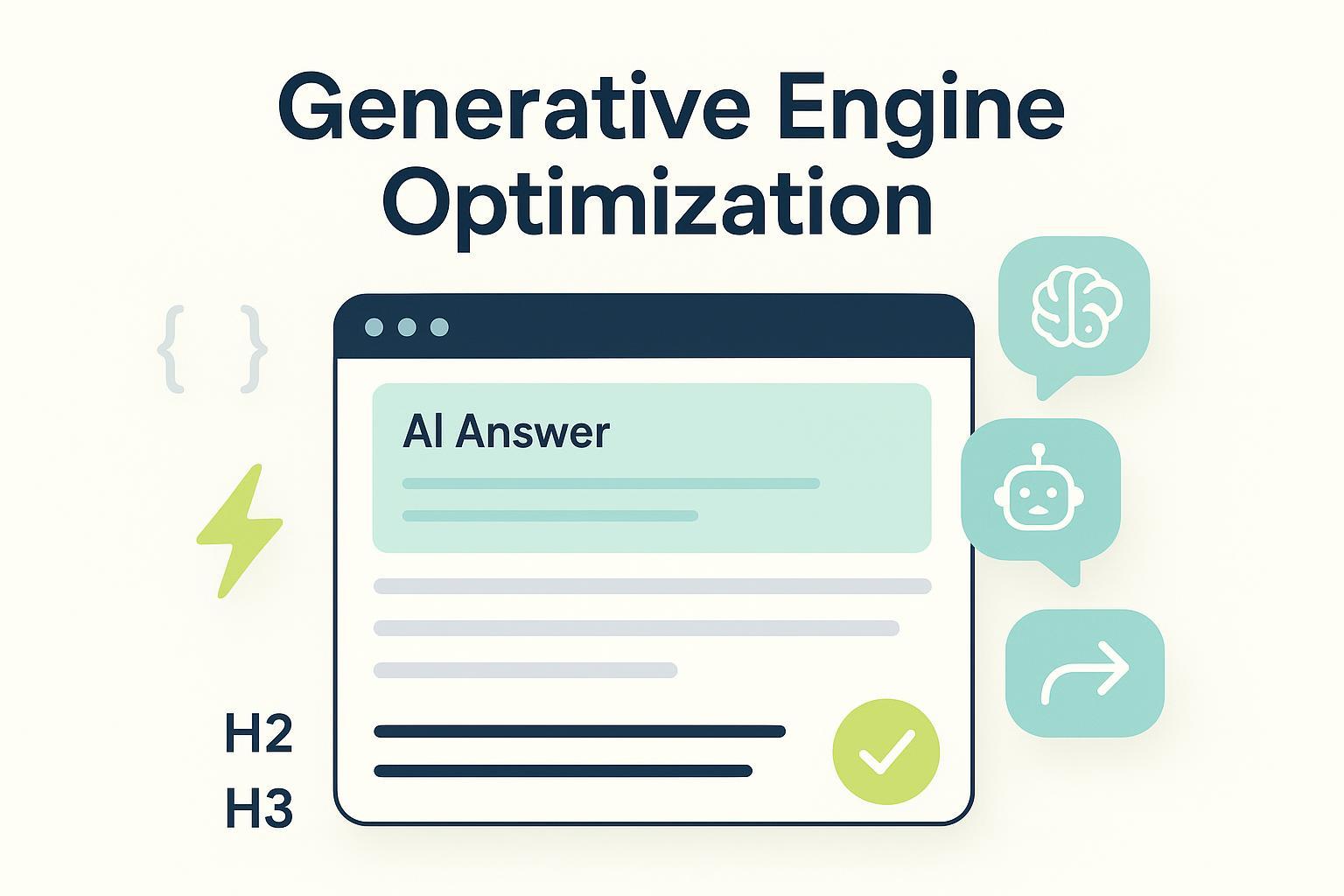Simple GEO Beginner Guide: Techniques Anyone Can Use
Discover beginner GEO techniques to get cited by AI answer engines. Easy, practical steps, clear structure, and real examples—perfect for non-experts.


You don’t need to be a technical SEO to show up in AI answers. With a few safe, repeatable tweaks, you can make your pages easier for generative engines to understand, cite, and send traffic to. This guide walks you through beginner-friendly steps that work for most websites—no jargon and no risky shortcuts.
What is GEO (Generative Engine Optimization)?
GEO is the practice of structuring and strengthening your content so AI-powered answer engines (like Google’s AI Overviews, ChatGPT, Perplexity, and Bing Copilot) can accurately interpret, synthesize, and cite it. Compared with traditional SEO, success is less about blue-link rankings and more about appearing as a cited source inside generated answers. For a concise industry overview, see Search Engine Land’s explanation of what generative engine optimization is and why it matters.
1) Lead with an answer-first format
Start key pages and sections with a crisp, 40–60 word definition or answer. Then expand with steps, examples, and sources. This makes it simpler for AI systems to extract the core statement and attribute it to you. See HubSpot’s GEO overview and formatting guidance and Frase’s beginner recap of answer-focused structure.
Tip: Put the short answer in its own paragraph near the top, then support it with scannable subsections.
2) Use clear headings and semantic richness
LLMs scan headings and surrounding context to piece together meaning. Use descriptive H2/H3 subheads—ideally shaped like the questions your readers ask. Sprinkle natural synonyms and related terms so models connect your page to the topic without keyword stuffing. HubSpot outlines how headings and semantic clarity aid AI interpretation in its GEO primer.
Example: Instead of “Best Practices,” try “How to add FAQ schema safely” or “What does AI cite in product reviews?” Notice how each option aligns to likely user questions.
3) Keep pages fresh
Stale facts reduce the chance of being cited in AI answers that prioritize recent, corroborated information. Schedule light updates: refresh stats, add current examples, and clarify datestamps. Search Engine Land highlights freshness as a practical GEO factor in its GEO guide.
Practical idea: Add a short “Updated on” note when you materially revise a page and make sure the content reflects the change.
4) Add basic schema (Article, FAQ, HowTo)
Structured data helps machines understand content type and intent. For beginners, focus on Article, FAQPage, and HowTo where they naturally fit. Follow Google’s guidelines (prefer JSON-LD, match visible content, validate) and test with the Rich Results Test. See Google’s intro to structured data and schema definitions for FAQPage and HowTo.
A minimal Article example (mirror values to visible on-page content):
{
"@context": "https://schema.org",
"@type": "Article",
"headline": "Simple GEO Techniques Anyone Can Use",
"author": {
"@type": "Person",
"name": "Your Name"
},
"datePublished": "2025-01-15",
"dateModified": "2025-01-15",
"image": "https://example.com/cover.jpg",
"mainEntityOfPage": {
"@type": "WebPage",
"@id": "https://example.com/simple-geo-techniques"
}
}
Two rules of thumb: only mark up what users can see, and validate before shipping.
| Schema type | When to use it | Beginner note |
|---|---|---|
| Article | Editorial content, guides, newsy updates | Include author, headline, dates, image, mainEntityOfPage |
| FAQPage | Real Q&A visible on the page | Use Question/Answer pairs; avoid invented FAQs |
| HowTo | Step-by-step instructions | List steps, tools; add images where relevant |
5) Improve titles, meta descriptions, and alt text
Write natural, question-aligned page titles and meta descriptions that reflect the core answer readers want. For images, use alt text that’s descriptive and relevant to the topic. These basics support accessibility and help engines map your page to the right intent. Search Engine Land covers on-page clarity and metadata in its GEO overview.
Quick check: If a newcomer skimmed only your H1, title, meta description, and first paragraph, would they get a trustworthy answer?
6) Strengthen authority signals
Trust is table stakes for citations. Make sure your author bylines include real credentials and that your business details (name, address, phone) are consistent across reputable directories. Seer Interactive explains how bylines, citations, and directory integrity bolster GEO; see its primer.
- Practical follow-up: For a beginner walkthrough on cleaning up listings, see this step-by-step guide: How to Update Directory Listings for AI Citations.
7) Mind your technical hygiene
Fast, mobile-friendly pages served over HTTPS—and clean crawl/index status—remain prerequisites for discovery by both classic search and AI systems. Google’s SEO Starter Guide covers crawlability, information architecture, and Core Web Vitals, while Search Engine Land reiterates these basics in its GEO write-up.
Routine tasks: monitor Core Web Vitals, fix broken links/canonicals, keep sitemaps current, and avoid blocking valuable pages in robots.txt.
8) Measure AI citations and referrals
You can’t improve what you don’t measure. Start simple with a monthly log and a handful of prompts tied to your key topics. Industry research from TryProfound documents platform-specific citation patterns and volatility; see their GEO 10-step guide. While exact referral behaviors evolve, the following beginner workflow is workable:
-
Manual checks: Run representative prompts in Perplexity, Bing Copilot, and ChatGPT. Note whether your URLs appear as inline citations, footnotes, or source panels. Re-check monthly; expect some “citation drift.”
-
UTM tagging: When sharing links in AI chat contexts, add source/medium UTMs (e.g., utm_source=perplexity|chatgpt|ai_overviews; utm_medium=ai). Segment in GA4 by UTM.
-
GA4 segmentation: Create an exploration for AI-attributed sessions by UTM or landing-page clusters. Compare engagement and conversions versus organic search.
-
AI Overviews: When AI Overviews surface links, track sessions and behavior for those landing pages. For a walkthrough, see Step-by-Step Guide to Tracking AI Overview Traffic.
-
Deeper dive: For broader setup and reporting flows, visit How to Track and Analyze AI Traffic: Complete Guide.
9) Monitor sentiment and representation in AI answers
Are AI answers describing your brand accurately and fairly? Skim outputs for tone, common claims, and which pages they cite. If something’s off, adjust your source content: clarify claims, add supporting evidence, and correct outdated details.
Practical workflow example (neutral tool mention): Disclosure: Geneo is our product. During your monthly checks, you can log which platforms cite you and how they frame your brand. A monitoring tool like Geneo can be used to track multi-platform citations and perform high-level sentiment analysis across answers, so you can spot patterns and decide which pages to update. Keep language objective in your notes—what’s the claim, what source did the AI cite, and what change will you make on your page?
- Related reading: Brand Sentiment in AI Search: Trust, Authority & Ranking Guide.
Your first 7 days: a tiny, realistic plan
- Day 1–2: Pick one high-potential page. Add a 50-word answer at the top. Tighten H2/H3s to question-style subheads.
- Day 3–4: Implement Article schema (JSON-LD). If you have genuine Q&A, add FAQPage schema and validate.
- Day 5: Refresh a stat or example and update the modified date. Check title/meta/alt text for clarity.
- Day 6: Fix one authority signal: author byline details and one reputable directory listing.
- Day 7: Set up a monthly log and GA4 segment for AI UTMs; run 10 prompts across two platforms and record citations.
Closing thoughts
Think of GEO as making your best answers clean, current, and easy to cite. Start with one page, measure lightly, then iterate. If you’d like help keeping tabs on AI citations and sentiment across platforms, you can try a monitoring workflow with a neutral toolset—Geneo included as an option—to centralize checks and reporting.
Looking for more depth? Explore Google’s docs on structured data and page experience, pair that with the industry overview from Search Engine Land, and keep a recurring reminder to refresh your key pages. Small, steady improvements add up—especially in AI-driven answer surfaces.




